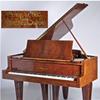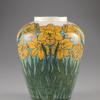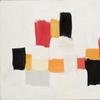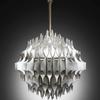Join Degas at the Opéra With This Virtual Tour of the National Gallery Exhibition
- April 28, 2020 15:20
Edgar Degas (1834–1917) is celebrated as the premier painter of dancers, a subject that dominated his art for nearly four decades. Degas's renowned images of the Paris Opéra are among the most sophisticated and visually compelling works he created. Celebrating the 350th anniversary of the Paris Opéra's founding, Degas at the Opéra presents approximately 100 of the artist's best-known and beloved paintings, pastels, drawings, prints, and sculpture. The exhibition went on view March 1 at the National Gallery of Art, Washington, DC, and continues now with online audio tours, lectures, video and a virtual tour while the museum is temporarily closed. A fully illustrated exhibition catalog is available.
A music lover and regular visitor to performances, Degas explored both the public spaces of the Paris Opéra—auditorium, stage, and boxes—as well as more private ones, including dance studios and backstage. He was friends with many of the people he depicted in his paintings, from dancers, singers, and orchestra musicians to the formally dressed subscribers. The Opéra also fueled some of Degas's most daring technical innovations, including his first monotype, The Ballet Master (Le maître de ballet) (c. 1876, National Gallery of Art), and his wax sculpture Little Dancer Aged Fourteen (1878–1881, National Gallery of Art), which revolutionized the medium.
"Although there have been many exhibitions celebrating Degas's love of the ballet, this will be the first to celebrate his enduring fascination with the opera. The Gallery has the world's third largest collection of works by Degas, from which several of his key works depictions of the Paris Opéra will be on view in the show," said Kaywin Feldman, director, National Gallery of Art.
The exhibition addresses the Opéra as an institution and Degas's passionate attachment to it through his personal relationships with successive Opéra directors, composers, corps de ballet, singers, musicians, conductors, and subscribers. From the mid-1860s through his later work made after 1900, the Opéra was the focal point for the artist. He explored its different spaces (orchestra, stage, boxes, foyer, corridors, dance studios), and examined the people active in those spaces. Degas's depiction of the dancer's body from every angle, under strain or in moments of relaxed waiting, reveals the psychological truth of the moment and is remarkable for its modernity in representing the human figure.
Degas used multiple viewpoints to frame a scene in unexpected ways. Through the contrasts of lighting, the juxtaposition of the darkened orchestra pit and the brightly lit stage, the study of movement, and the spontaneous gestures that masked patient study and constant practice, the Opéra became a laboratory that allowed him to explore the constant interplay of form and substance.
Rejecting the idea of painting from nature, Degas presented an Opéra filtered by memory and enriched by his imagination. He invents the scenes of orchestras, views of the auditorium, the stage and behind the scenes, dance classes, and examinations in the studio. Each scene and subject called for its own medium: paint for the slow precision of the dance classes; pastel for the dazzling colored ballets; black-and-white monotypes for the amorous liaisons behind the scenes; and drawing for the dancers' fleeting poses or movements.
Arranged thematically in eight galleries, Degas at the Opéra opens with his most famous works inspired by the Opéra: Mlle Fiocre a propos of the Ballet "La Source," (c. 1867–1868, Brooklyn Museum) and The Ballet from "Robert le Diable" (1871, The Metropolitan Museum of Art). Although they depict specific operatic performances, these paintings speak directly to Degas's profound attachment to and engagement with the Opéra as well as his distinctive approach to its presentation.
Degas also depicted his circle of friends, the performers, musicians, and others who were associated with the Opéra, including the portraits of soprano Rose Caron and cellist Louis-Marie Pilet, in addition to drawings of writer and librettist Ludovic Halévy. Among the highlights of Degas's musical circle is his portrayal of bassoonist Désiré Dihau that appears in his extraordinary and unconventional painting, The Orchestra of the Opera (c. 1870, Musée d'Orsay), as well as in Musicians in the Orchestra (Portrait of Désiré Dihau) (c. 1870, Fine Arts Museums of San Francisco).
The exhibition continues with works that illustrate Degas's interest in representing performers in candid moments in rehearsal rooms, offering rare glimpses into the backstage life and the rigorous training of the dancers. Several of the works on view are set in the practice rooms of the Opéra house on the rue Le Peletier—destroyed by fire in 1873—including The Dance Class (1873, Musée d'Orsay) and The Dance Class (c. 1873, National Gallery of Art).
While Degas showed little interest in documenting actual performances, he was intrigued by the public spaces of the Opera. He produced works that incorporate unconventional viewpoints into and out of the backstage wings, looking down at the stage from the opera boxes, or up from in the orchestra pit. Among the works on view that show such dynamic representations are Yellow Dancers (In the Wings) (1847/1876, The Art Institute of Chicago), The Curtain (c. 1880, National Gallery of Art), and Dancer with a Bouquet Curtseying on Stage (1878, Musée d'Orsay).
The Paris Opéra not only supplied a variety of subject matter for Degas to explore, but it also fueled his passion for experimenting with materials and format. Degas created decorative fans beginning in the late 1860s, using the semicircular format to explore compositional space in increasingly complex ways. Eight of these fans are on view, including Dancers (1879, Tacoma Art Museum), Ballet (c. 1880, Musée d'Orsay), and La Farandole (c. 1870, private collection). He took these experiments even further in a series of panoramic frieze paintings begun in the late 1870s. Among the six frieze paintings featured in this exhibition are Dancers in the Rehearsal Room with a Double Bass (c. 1882–1885, The Metropolitan Museum of Art), Dancers in the Green Room (c. 1879, Detroit Institute of Arts), and Dancers in the Classroom (c. 1880, Sterling and Francine Clark Art Institute).
The body of the dancer captured both in motion and at rest was a source of fascination and inspiration for Degas. Several drawings on view will show that while many served as studies for other works, it was the process of creation itself that motivated him. Some highlights on view are Three Nude Dancers (c. 1903, Arkansas Arts Center Foundation Collection) and Three Dancers (1900–1905, private collection) that depict dancers in motion, while other works, such as Dancer, Half-Length, Arms Crossed Behind her Head (c. 1890, Statens Museum fur Kunst) and Study of a Dancer (1874, private collection), show dancers in a specific pose.
Degas provided rare insights into the life of performers behind the scenes, especially that of the ballet "rat," as young dance students were known, and investigates both the humor and the seriousness of the difficult and demanding life of the ballet dancer. A bound volume of etchings, La Famille Cardinal (1938/1939, National Gallery of Art), as well as a series of monotypes, both of which are based on La Famille Cardinal, a study of lower-class Parisian life during the early years of the French government's Third Republic (1870–1940), written by Halévy. Degas's most famous work on the theme of the dancer in training, the wax sculpture, Little Dancer Aged Fourteen (1878–1881, National Gallery of Art), will be installed, alongside a bound volume of pencil sketches depicting ballet dancers (c. 1877, The J. Paul Getty Museum).
Even as his eyesight failed later in life, Degas continued to draw inspiration from the Opéra. The exhibition concludes with his late works, many of them in pastel, in which Degas abandoned the precision of his early works. Later works such as Blue Dancers (c. 1890, Musée d'Orsay), Dancer with Bouquets (1895–1900, Chrysler Museum of Art), and Ballet Scene (c. 1907, National Gallery of Art) show the vibrant colors and bold silhouettes that he favored.





















